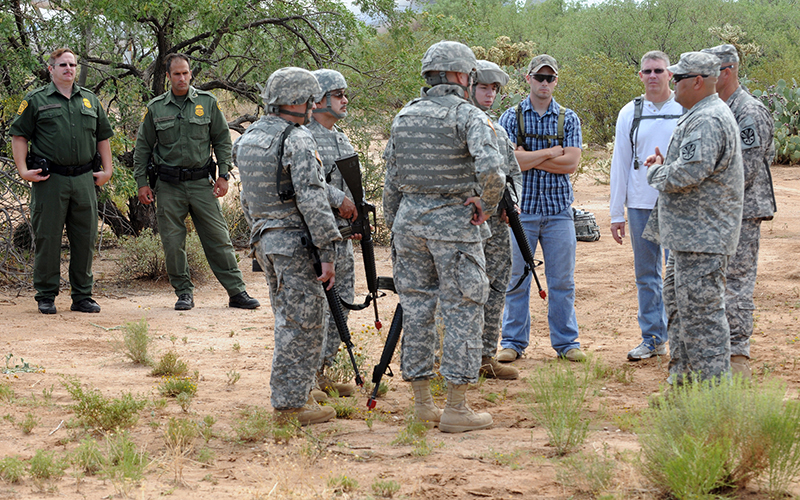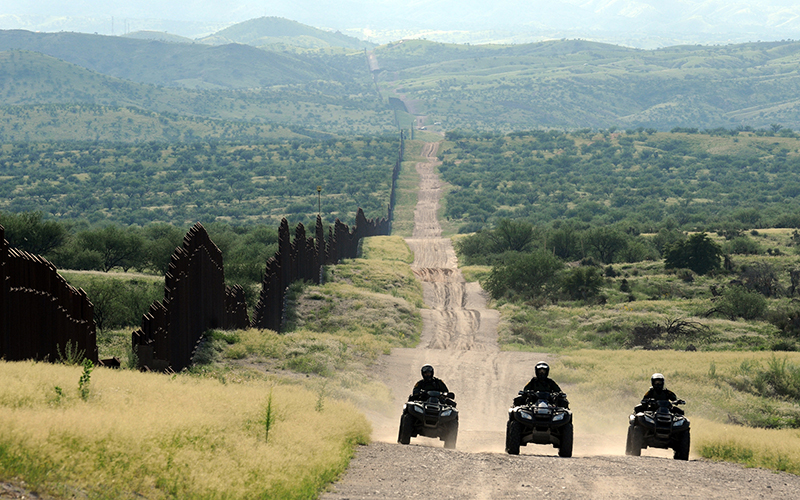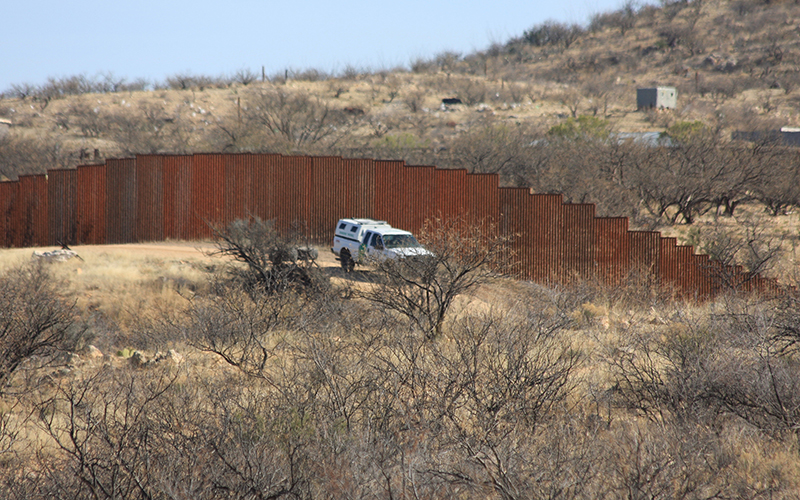
As in border previous deployments, like this one in 2010, National Guard troops will only provide support for Border Patrol agents. They will not have arrest authority and might not carry weapons, thogh details are still being worked out. (Photo by Staff Sgt. Jim Greenhill)

Border Patrol agents ride along the Mexican border near Nogales in this 2010 file photo. Arizona Gov. Doug Ducey said he will deploy 150 National Guard troops to the border next week as part of a four-state effort to boost border security.(Photo by Staff Sgt. Jim Greenhill)
WASHINGTON – Arizona will send about 150 National Guardsmen to the border next week as part of President Donald Trump’s plan to send troops to the border, Arizona Gov. Doug Ducey announced Friday.
While the White House and the governors of the four border states are still working on details of Trump’s Tuesday call to send guardsmen to support border control, administration officials have said the deployments will likely mirror operations under past presidents.
But a Government Accountability Office audit after the deployments ordered by Presidents George W. Bush and Barack Obama said that while they did have some success in combating illegal border activity, the operations had numerous problems and were inefficient.
Bush’s Operation Jump Start and Obama’s Operation Phalanx helped Border Patrol agents make 204,701 arrests and seize 372,706 pounds of marijuana, but at a cost of $1.35 billion. Restrictions on the guardsmen required two to patrol the same area of one Border Patrol agent could, who had to be called in for apprehensions because the soldiers were not allowed to make arrests.
Those are the same ground rules the Trump administration is talking about now, but Rep. Paul Gosar, R-Prescott, said he thinks the results will be different this time around because of this president’s focus on border security.
“They’re going at a time when the president is petitioning Congress to start looking at building the wall and he made proposals for other opportunities,” Gosar said Thursday.
Gosar sees the deployment as worthwhile because the guardsmen will be “eyes and ears as they see people, so they can alert Border Patrol so they can actually make them become more efficient at their job.”
Related coverage:

Ducey sending 150 National Guard troops to border, questions remain
Though administration officials stress that it is too early in the process to get into specifics, a few details have emerged.
Trump said Thursday that he wants to send between 2,000 and 4,000 guardsmen to the border, which would put this deployment somewhere between the 1,200 in Operation Phalanx and the 6,000 in Operation Jump Start. While those were expected to be only short-term operations, however, Trump said “we’ll probably keep them or a large proportion of them until such time as we get the wall.”
Homeland Security Secretary Kirstjen Nielsen said this week that the guardsmen will be deployed under Title 32, which means they will be federally funded but still under command and control of their respective governors.
While Title 32 allows guardsmen to participate in law enforcement activities, administration officials have stressed that those deployed this time will not make any arrests – the same rules that were in place under Bush and Obama.
A Defense Department statement Thursday said the deployed guardsmen “will act in support of Border Patrol agents who are performing law enforcement duties.”
But the GAO audit said the previous operations were inefficient, despite any arrests that came from them, because of the restrictions placed on guardsmen, who had to travel in pairs and had no arresting authority.
The 6,000 guardsmen in Operation Jump Start came from border and other states, and cost $1.2 billion. Operation Phalanx deployed 1,200 guardsmen, exclusively from border states, and used Customs and Border Protection equipment instead of National Guard equipment, reducing costs to about $145 million for the 2010-2011 period studied in the audit.
The report also found that because there was no “comprehensive strategy,” National Guard troops were unable to plan for a specific role. And the “ad hoc” nature of the deployments made it difficult for Customs and Border Protection officials to plan for long-term border security.
The Pentagon did not respond to a request for comment Friday and Homeland Security officials said they would not be able to respond. But in a statement Thursday, the Defense Department said it has created a “cell” of its officers to act “as the single conduit for information and coordination between DOD and DHS.”
One concern cited in the GAO audit of the previous deployments was that too much militarization of the border could strain relations with Mexico. The Mexican government raised concerns about militarization again this week.
The Mexican Foreign Ministry said Wednesday it has been assured by Nielsen that deployed guardsmen will exclusively act in a support role and “will not carry weapons or have immigration or customs duties.” The Wednesday statement said Mexico has been working with the U.S., but ultimately has to act in its own interest.
“In all of its communications on the topic, the Mexican government has stated to the U.S. government that if the announced deployment of the National Guard results in the militarization of the border, it would seriously damage the bilateral relationship,” the ministry statement said.
But Gosar said he is not worried about damaged relations with Mexico. Any Mexican reaction will hurt it in its ongoing renegotiation of the North American Free Trade Agreement, he said.
“They need to be good neighbors because they have to hold up our border, just like our enforcement, just like they expect us,” Gosar said. “That’s a key component and if they don’t, I guess we got some problems with NAFTA.”